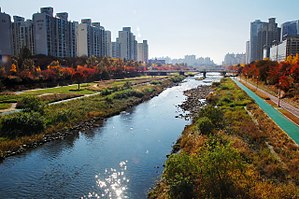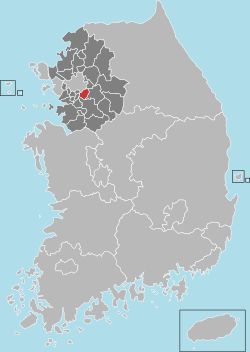You can help expand this article with text translated from the corresponding article in Korean. (July 2012) Click [show] for important translation instructions.
|
Seongnam
성남시 | |
|---|---|
| Korean transcription(s) | |
| • Hangul | 성남시 |
| • Hanja | 城南市 |
| • Revised Romanization | Seongnam-si |
| • McCune–Reischauer | Sŏngnam-si |
 Bundang District of Seongnam | |
 Location in South Korea | |
| Country | |
| Region | Gyeonggi Province (Sudogwon) |
| Administrative divisions | 3 gu, 44 dong |
| Government | |
| • Mayor | Shin Sang-jin (People Power) |
| Area | |
• Total | 141.70 km2 (54.71 sq mi) |
| Population (September 2024[1]) | |
• Total | 914,832 |
| • Density | 7,032.10/km2 (18,213.1/sq mi) |
| • Dialect | Seoul |
Seongnam (Korean: 성남; Korean pronunciation: [sʰʌŋ.nam]) is the fourth largest city in South Korea's Gyeonggi Province after Suwon[2] and the 10th largest city in the country. Its population is approximately one million. It consists of three administrative districts: Bundang District, Jungwon District, and Sujeong District.
Seongnam, one of the foremost planned cities in South Korean history, was conceived during the era of President Park Chung Hee for the purpose of industrializing the nation by concentrating electronic, textile, and petrochemical facilities there during the 1970s and 1980s. The city featured a network of roads, to Seoul and other major cities like Gwangju, Gyeonggi, from the early 1970s on. Today, Seongnam has merged with the metropolitan network of Seoul. Seongnam has also served as a ′test bed′ of South Korea's urban planning history. Bundang, one of the successful new town projects in the country, has been settled in a southern half of Seongnam since 1991.
The city is also home to K League football club Seongnam FC.[3]
- ^ "Population statistics". Korea Ministry of the Interior and Safety. 2024.
- ^ "Suwon City". Archived from the original on June 14, 2018. Retrieved June 14, 2018.
- ^ 성남시민프로축구단. Archived from the original on September 29, 2016. Retrieved June 14, 2018.

